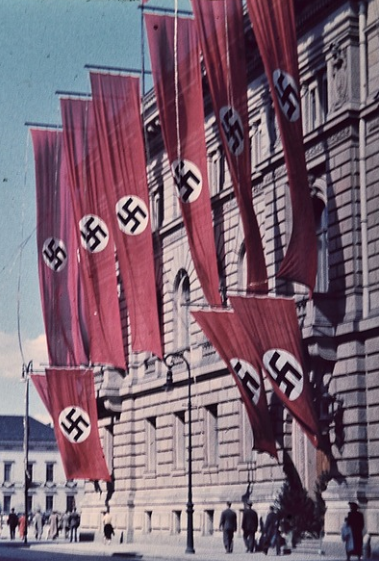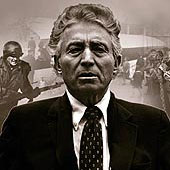Shooting Germany: 1944-1949
What does it take to be a photographer in wartime Germany — and peacetime New York City?
June 5, 2010

I entered Germany at the cold and bitter battle for the Hürtgen Forest on December 6, 1944, in which about 68,000 soldiers — Americans and Germans — lost their lives.
I was a private first class in the Intelligence Platoon of the 2nd Battalion, 331st Regiment, 83rd Infantry Division, “Ohio,” of the U.S. Army.
My assignment — usually with three other soldiers — was to go behind the enemy lines at night. We were to make contact with the local inhabitants, gather information about enemy activity — and return to Headquarters with whatever they told us.
Like the other GIs, I carried a rifle in my hands. But what set me apart was the Argus C-3 35mm camera hanging around my neck — always ready for the next shot. By the end of the war, I had taken nearly 7,000 photographs.
My night work as part of the intelligence force left me more or less free during the day to take pictures of whatever I experienced. When I was not on a night mission, I processed my films in four army helmets and hung the wet negatives from tree branches to dry.
My own dream was to become a magazine photographer and get a job on LIFE or a similar publication in America after the war. Whether I would ever realize this dream depended on surviving the war and becoming a good enough photographer by the end of the war to secure such a job.
New beginnings
When the war ended on May 8, 1945, I was in the hamlet of Hohenlepte. Here my combat photography came to an end — and my chronicle of the occupation of Germany began.
A few days after the end of the war, we were pulled back west of the Elbe to the beautiful Harz Mountains. By now, I had become one of the photographers for the division paper — 83rd Division Thunderbolt.
The cessation of hostilities in Germany brought about a new phase of operations, the occupation and governing of Germany. Nazi party members had to be replaced by non-Nazis in minor administrative jobs.
Stationed at Anderbeck and later at Seesen, I covered the activities of our Division personnel as they interacted with the local population from Braunschweig to the Elbe.
I was determined to get to know the German people — and the ones I got to know first were those who had the same profession as myself: photographers. Whenever I moved to a new town, I contacted the local photographers. They were only too happy to have me share their facilities, usually in exchange for some favor which I gladly obliged.
Meanwhile, American soldiers were still fighting and dying in the South Pacific.
It was rumored that soon we would be sent to Trieste, Italy and shipped to Japan. The fear of getting killed or maimed in a war was still very much present with me.
We learned soon after that we were to remain in Germany. The headline from August 12, 1945 read: “Passau, Germany: Japan Surrenders. Peace on Earth. The Atomic Bomb Presents New Problems for Future Wars.”
And in next to no time, on September 24, I was ordered to return immediately to the United States and civilian life. The U.S. Army had no further use for me.
Groundwork for a career in the United States
However, I had started various projects in Germany that I wanted to complete. I also felt that I had not yet mastered photography to the point of securing a good job at a magazine back in the States.
I needed to learn more about my future profession and I felt that Germany would be the ideal place to do so. Still, I could not remain without a civilian job with the Occupation Forces.
By chance, there was an opening for a photographer with the U.S. State Department at the Audio Visual Aids (AVA) section, based in the I.G. Farben building in Höchst, near Frankfurt.
Twenty photographers applied for the job, but I was the first one in line and got it. My war portfolio and pictures of the early occupation days in Germany helped my bid.
Most of my work at AVA was in the darkroom, and since I had no car, the bulk of my photography was done in the Frankfurt area.
In May 1946, I managed to buy a Jeep, a new Leica C-III and a Rolleiflex — and spent the rest of that year traveling everywhere I could go in Germany in my spare time. I loved the German countryside with its castles, monuments, colorful mountains, valleys and lakes.
Many stimulating things were going on in Germany at that time and I tried to cover them all — such as the first postwar motor race and even a bicycle race.
These events were photogenic because the participants were using old outdated vehicles and work outfits that needed, in order to function, a great deal of repair, ingenuity and prayer.
The next generation
In the midst of this rebirth, I felt that children were very often left to fend for themselves. What was to become of these orphans of war?
Boys may have suffered even more than girls, who had womenfolk to raise them, but many families had no man in the house to bring up the boys. Their fathers and other male relatives had been killed, maimed — or were still being held prisoner in the Soviet Union.
Often, I saw children without shoes and who were poorly clothed. It was a perfect scenario for an entire schizophrenic or depressed state in the male line of future generations.
I tried to capture with the camera what I saw of those children.
Roads, bridges, factories, houses and entire cities had to be cleared of rubble and rebuilt. When I was a child, before the war, Germany had been the technological center of the world.
It had just invented the stainless steel which made all its metal products shine, while those of other countries eventually rusted away. Now, at the start of a new era, it was on its knees and I wanted to chronicle how it would rebuild itself from year zero.
At AVA, we had plenty of parties — which honestly bored me. While there, I had very little work published. But on January 1, 1947, things changed.
I started working for Weekend picture magazine — the Sunday supplement of the U.S. Army newspaper The Stars and Stripes, which was based in Pfungstadt, near Darmstadt. These were the golden years of my photography in Germany.
For nearly three years, until 1949, Weekend kept me constantly on the road in West Germany doing photo picture stories on all manner of subjects. I was now being published every week.
World War III
Unfortunately, a personal tragedy occurred at Weekend. While I was on assignment in Spain, nearly 4,000 of my negatives were destroyed in a flood in Weekend’s darkroom. It represented virtually all my work in Germany to that date.
In 1948, the Soviet Union instituted the Berlin Blockade which resulted in the Allied airlift to supply the beleaguered city with food, fuel and other necessities. I and many others thought WW III could begin at any moment.
Instead, it turned out to be the turning point in German-American relations. Before the airlift, I had never seen us working together with the former enemy with such esprit de corps.
It was a great challenge. The Soviets wanted to starve out 2.1 million Berliners and oust the British, French and Americans from West Berlin — a bastion of hope and freedom in the heart of the East Zone of Occupation. I was very busy on the airlift where the Allies and the Germans worked as one — 24 hours a day.
My hope was that German and American friendship might set an example for other people in the world.
Far too often, enemies in war remain enemies after the peace accord has been signed. History tells us that our species has really never lived in peace. It has only alternated from periods of cold wars to hot ones in a never-ending cycle.
The picture of German children embracing a GI at Tempelhof Airport in West Berlin showed that we were no longer the enemies of the Hürtgen Forest days. With that picture, I knew I could go home.
Germany was well on its way to recovery — and for my part, I felt quite secure in my profession. My photographs had won all the photo contests that had been held in Germany. Afterwards, I ceased participating, but became one of the judges until mid-1947.
The bullets, shrapnel and the devastated streets of Germany, tilled with the display of raw feelings had been my university course and basic training for civilian life in the United States. I had seen my fair share of uncertainty, fear, hate, arrogance, regret, hunger, pathos, shame, anguish, despair, delusion, corruption — but also cooperation and friendship.
The pictures in my book — “Entering Germany: 1944-1949” — cover all these emotions and are those through which I learned photography. When I returned to the United States, the key question on my mind was this: Were my kind of images good enough for the New York savants of my profession? Could I compete with the best New York had to offer?
I had trained myself in the cauldron of battle and the streets of Germany. That work had prepped me for such popular magazines as Look and LIFE. And, for a while, I worked for both of them.
A new challenge
But, while photographing movie stars in Hollywood in August 1950, I happened upon a copy of Flair Magazine, which convinced me that after eight years of hard training, my tastes had changed. I no longer wanted to be incarcerated in the confines of Look or LIFE photojournalism.
Now I had a new challenge. I felt I had to work for the most advanced and sophisticated magazine I had ever seen — Flair, where photography had no subject or creative boundaries.
I wanted to take photography apart and begin anew. I wanted to make Flair more vigorous. I drove back to New York and went straight into the darkroom to print a special portfolio for Flair’s editor Fleur Cowles. It happened that Flair was looking for a photographer.
When I delivered my portfolio to the picture editor, I saw on her desk the portfolios of many of the top photographers of the world.
I thought I had no chance against them, but with great joy I learned that I had been selected as Chief Photographer of Flair — which I am convinced to this day is the most beautiful magazine ever published at any time, anywhere.
Adapted from “Entering Germany: 1944-1949” by Tony Vaccaro. Published by TASCHEN. Copyright © 2001 TASCHEN. Used by permission of Tony Vaccaro.
View Tony Vaccaro’s photographs from “Entering Germany: 1944-1949” here.
Takeaways
In 1948, the Soviet Union instituted the Berlin Blockade, and I — and many others — thought World War III could begin at any moment.
Like the other GIs, I carried a rifle in my hands. But what set me apart was the Argus C-3 35mm camera hanging around my neck.
With the picture of German children embracing a GI at Tempelhof Airport in West Berlin — I knew I could go home.
I had trained myself in the cauldron of battle and the streets of Germany — but could compete with the best New York had to offer?
When I was a child, before the war, Germany had been the technological center of the world. Now, Germany was on its knees — and I wanted to chronicle how it would rebuild itself from year zero.
Read previous
Dateline Germany: The Ballack-Boateng Case
June 4, 2010
